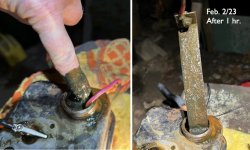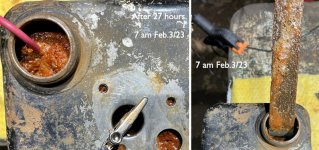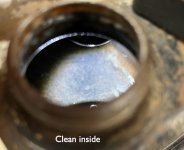Years ago I had used electrolyis to try and clean the bore of a Boer War-era .303 Martini but had forgotten about it until my neighbor's 15 y.o. son, who is into engines, ATVs etc., asked me how to get the rust out of a gas tank and I went online.
Most articles suggested using a 12v car battery charger set to 2A but mine didn't work. Despite being 10 years old, it was presumably "smart" enough to know that there was no battery attached, so I used a 12v DC power supply I'd got to run a diesel heater. (A Chinese knock-off of a Wabasto and very handy for things like drying painted objects in cold weather until they off-gass enough to bring them inside.)
I did some experiments before he brought over the Briggs & Stratton tank. I washed it out with warm water and Simple Green, made an anode from some 16 ga. steel and carefully suspended it in the tank and filled it with a solution of water and washing soda.
Overall, it took nearly 48 hours and two changes of electrolyte and cleaning of the anode but it did come out pretty clean. There must have been more rust inside than we could see.
A useful technique for removing rust from tools when you can't always get them completely apart.




Most articles suggested using a 12v car battery charger set to 2A but mine didn't work. Despite being 10 years old, it was presumably "smart" enough to know that there was no battery attached, so I used a 12v DC power supply I'd got to run a diesel heater. (A Chinese knock-off of a Wabasto and very handy for things like drying painted objects in cold weather until they off-gass enough to bring them inside.)
I did some experiments before he brought over the Briggs & Stratton tank. I washed it out with warm water and Simple Green, made an anode from some 16 ga. steel and carefully suspended it in the tank and filled it with a solution of water and washing soda.
Overall, it took nearly 48 hours and two changes of electrolyte and cleaning of the anode but it did come out pretty clean. There must have been more rust inside than we could see.
A useful technique for removing rust from tools when you can't always get them completely apart.




